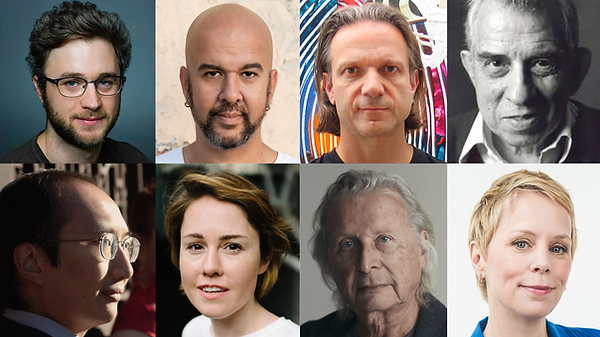CONCERTS
SPRING 2022
APRIL 11, 8PM
FALLEN ANGELS:
Music by Tania León, Michel Galante, Brian Ferneyhough, Michel Galante, Yotam Haber
APRIL 20, 7:30PM
to live for you, to die for you
Alma Mahler, Patricia Alessandrini, Sang Song,
Gustav Mahler
2024-25
Schumann's Dilemma:
New Voices, New Answers
Sunday, April 26, 2025 at 2pm

PROGRAM
Aldo Clementi
Concerto for Piano and Instruments (1986)
David Kaplan, piano
performed as a sound installation
Robert Schumann, arr. Kimmy Szeto
Overture, Scherzo, and Finale, op. 52 (1845)
arranged for chamber ensemble
Michel Galante, conductor
~ * ~ * ~
Excerpts from Davidsbündlertänze (1837) by Robert Schumann
and from New Dances of the League of David (2014)
miniatures for piano commissioned by David Kaplan
Michael Gandolfi
Mirrors and Sidesteps (2015)
Robert Schumann
Lebhaft from Davidsbündlertänze
Augusta Read Thomas
Morse Code Fantasy - Homage to Robert Schumann
Robert Schumann
Etwas hahnbüchen “Ganz zum Überfluss meinte Eusebius noch Folgendes, dabei sprang aber viel Seligkeit aus seinen Augen from Davidsbündlertänze
Marcos Balter
***
Caroline Shaw
XVI Mit gutem Humor, un poco lol ma con serioso vibes
Robert Schumann
Ganz zum Überfluss meinte Eusebius noch Folgendes, dabei sprang aber viel Seligkeit aus seinen Augen from Davidsbündlertänze
~ * ~ * ~
Tristan Murail
Une relecture des Kinderszenen de Robert Schumann (2019)
for flute, cello and piano
When Daniel Barenboim said “Schumann has a concept of music, but not really a concept of sound,” he was referring to works like Syrinx, which, in place of music, simply has three signs on the score : ***, or works like Humoresque, which includes notated musical lines that the performer is instructed not to actually play, but instead to hear only in their mind. In short, Schumann’s music raises more questions than it answers. It’s because of this that many contemporary composers have been tempted to step into his fertile creative ideas, ideas that take tremendous pleasure in free musical thought, invention, and fantasy, often breaking out of the world of sound into a world of inspired abstractions. This concert focuses on contemporary composers who responded to Schumann’s provocations: Aldo Clementi, Augusta Read Thomas, Caroline Shaw, Michael Gandolfi, Marcos Balter, and Tristan Murail.
Aldo Clementi creates a spatialized image of Schumann’s musical brain through his Concerto for Piano and 14 Instruments. The source material is Schumann’s Novellette no. 8, op. 21, which juxtaposes utterly tragic music sections in F-sharp minor with completely light, carefree character music in D-flat major, and idealistic music in D major, never reconciling them, as if they are homeless fragments from disparate works. Clementi takes these fragments and interpolates them at different stations in the concert hall: one station for the solo piano, flute, and violin; one station for clarinet, violin, and oboe; one station for horn, viola, and trumpet, one station for bassoon, cello, and bass, and then one station for celesta, harp, and glockenspiel. Clementi’s Concerto is completely unique and unlike any other work in contemporary music. It is a graphic, 3D, experiential metaphor for Schumann’s compositional mind.
Schumann’s Overture, Scherzo, and Finale, op. 52 is a collection of fragments on a different scale: this piece was meant to be his first "symphony" in three movements, but he was unable to find way to create a slow movement to balance the symphonic form that was expected at the time. Composed simultaneously with his "Spring" Symphony, in the early months of his marriage to Clara, Robert experienced a creative "spring" -- renewed musical energy flowed into the scores, only held back by the sound of the orchestra. Kimmy Szeto's arrangement for chamber ensemble polishes the sound apparatus to a crystalline clarity for Schumann's music to glimmer.
Tristan Murail, who established an international presence outside of France through his 12 year residency in New York, wrote that Schumann’s Scenes from Childhood has musical, expressive and evocative potential that far surpasses Schumann's version for piano. Almost all of them are little masterpieces, with great inventive power, based however on simple and concise ideas.” For his work for alto flute, cello, and piano entitled Une relecture des Kinderszenen de Robert Schumann, Murail writes “for my vision of Scenes from Childhood, I did not hesitate to use the entire modern palette of instrumental techniques, thus multiplying available timbres and the acoustic effects resulting from their combinations.”
Between 2013 and 2015, American pianist David Kaplan commissioned 17 composers to create a cycle of piano works inspired by Schumann. Argento presents four outstanding works from this collection, all by American composers. To name a few, Augusta Read Thomas’s Morse Code Fantasy, leaves the most memorable impression of all the works because it completely captures the raised-question spirit of Schumann. It does so by working on several levels: a purely musical level, and an implied “signaling” level derived from its morse code. The listener has no choice but to listen in two ways simultaneously. Caroline Shaw’s mit gutem Humor, un poco lol ma con serioso vibes, is the briefest possible representation of Schumann’s extroverted Florestan followed by his introverted Eusebius. Marcos Balter insists on Schumann’s mind bending eccentricity in his work ***.
Discussion with members of Argento to follow the concert.
